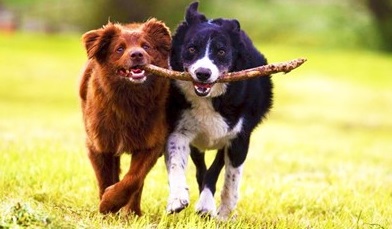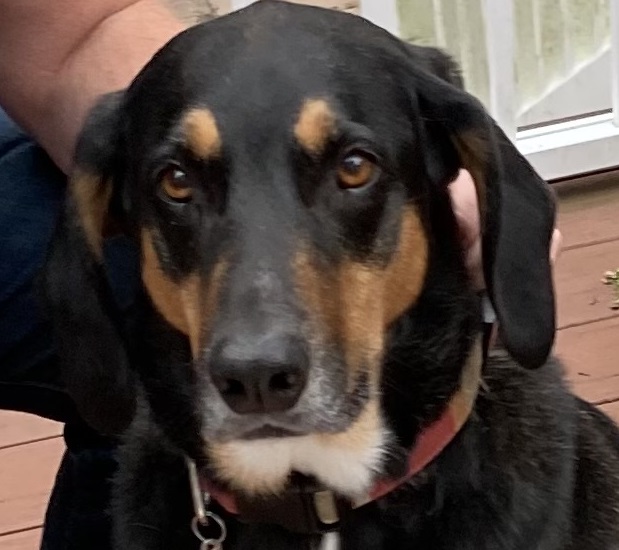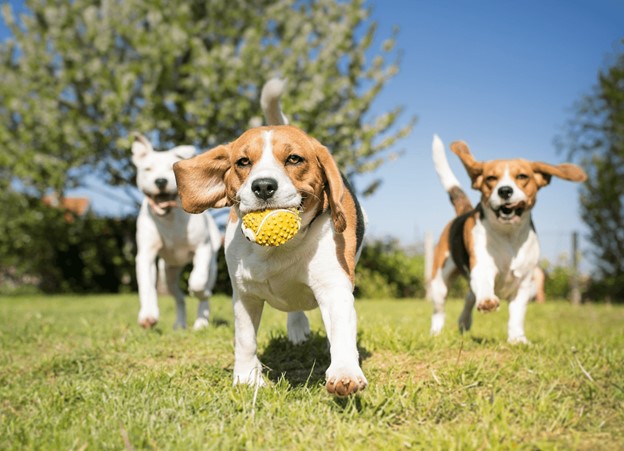The Dog Park - a Great Place (and Not Just for Dogs!)
On a recent visit to the dog park, Dolan, our hound mix, was off in the distance playing among a group of five dogs. I was standing next to a woman named Leigh whose yellow lab was one of Dolan’s favorite companions. After a few minutes, Leigh realized it was time for them to leave.
“C’mon, Max,” she called out. It was to no avail. Max was not ready to go. Leigh pulled a treat from her pocket and waved it. Max caught a glimpse. There was no mistaking that signal. Max bolted toward Leigh at Mach 3 speed with the other dogs in hot pursuit. He slid into an abrupt halt directly in front of her, his weighty tail wagging so fiercely it created a breeze that could be felt up to a few feet away. Though panting heavily, Max couldn’t contain his exhilaration at the thought of the morsel, his rejoicing suggestive of lottery winning jubilation.
The other dogs stood just behind Max, hopeful with anticipation that a biscuit might be tossed their way. Leigh reached into her pocket only to discover that the cupboard was bare. Feeling badly, she reached out to pet each one, a substitute that managed to ease the disappointment the dogs had momentarily experienced. By the time Max had finished – well, actually it took but a millisecond – they seemed to have forgotten the entire episode and had begun to wander off. (Ah, if only we humans could move on from disappointment that effortlessly!)
Max headed to the gate to welcome an incoming dog. As Leigh followed, she looked back at me and said, “He thinks he’s a person.” She then affixed the leash to Max’ collar and they were off.
I’ve come to appreciate how important the dog park is these days. And not just for the dogs.
The dog park we bring Dolan to, like many others, has two sections, one for small dogs and one for big dogs. On summer evenings and weekends, the dog park is bustling! There could be upwards of fifteen in each section.
Perhaps the most unmistakable aspect of the dog park is just how friendly a place it is. Although this amicable atmosphere is certainly not always the case, in the dog park lots of things that seem to count elsewhere, like whom you voted for or what you do for a living… well, in the dog park, these concerns are decidedly less relevant. The purpose of being there – to spend time with our dogs and allow them some fun and exercise – overshadows much of that.
Sure, every now and then someone shows up with a destabilizing agenda. They might be unaware of, or worse, unconcerned about their dog’s ill-suitedness to safe play, like the dog who growls menacingly or even snaps at other dogs.
Or, on occasion you encounter someone who can’t help but project their competitive inclinations through their dog. Like the time I leaned over to pet a stately German Shepherd. His person walked over and remarked that his was a “special dog.” I smiled and replied, “He sure is. I think the same about Dolan,” pointing to him as he was obsessively sniffing the base of a tree.
Well, this didn’t fit with the man's need to believe that his dog was more special than Dolan and all the other evidently pedestrian varieties loping around the dog park.
The man turned to me and announced, “He knows seven words for attack.”
Caught off guard with a topic that seemed more befitting a canine paramilitary training facility, I asked why he would need to know even one word, let alone seven.
My question triggered – wait, poor choice of word, let’s go with evoked – unbridled glee as it was evident that he was about to launch into his favorite subject, his dog’s aptitude for combat.
“The seven words are necessary because we can think of attack on a continuum from mild to forceful to severe, depending on the aggressor’s conduct,” he reported, feigning dispassion, which was given away by a smile and animation of hands that he sought to subdue.
“Level one involves no contact. Major—” he began (at the sound of his name, Major snapped to attention and fixed a stare on his Company Commander, I mean his person, as though waiting for instructions), “—positions himself in front of the aggressor and engages him only with verbal management to achieve restraint.”
I took this to mean he barks.
“Level two takes it one step further. Now Major uses a minimal level of physical apprehension to achieve restraint. Generally, this involves placing his mouth over an arm, but Major is careful not to execute a wound-inducing maneuver.”
“Level three is instituted when the aggressor’s behavior fails to abate, and the threat of fight or flight has escalated. In level three, Major is permitted to exercise some discretion in disabling the aggressor.”
Major can exercise discretion? Is this conversation actually happening? At a dog park?
I asked, “Why was Major trained this way? Was he used in policing or the military?”
“Oh, no,” he replied. Then he added, quite matter-of-factly as if stating the obvious, “It’s just for the sport.”
I glanced over at Dolan. He had just pooped. Major appeared to be scanning the dog park for suspicious activity.
Dolan did not love hanging out with Major and I must admit, I felt the same about the man. I thanked him for his explanation as I started to walk away, indicating the poop bag as my reason for leaving.
“Just one more quick thing,” he said. I turned back. He continued, “Each level builds on the preceding level, all the way up to level seven. That’s when Major is commanded to execute lethal force. Of course, this would be extremely rare.”
Extremely rare. Not never? For a dog not involved in law enforcement? Seriously? Now we crossed the boundary from surreal to downright bizarre.
I couldn’t get away fast enough, for the first time ever being grateful for the opportunity to clean up dog poop. As I walked away, I was just hoping no one in the dog park inadvertently uttered one of the seven deadly words you can’t say at a dog park.

On another visit to the park, Dolan was running in the field with a majestic looking dog with thick gray fur that I recognized as an Alaskan Malamute. His person noticed that I was admiring his dog. He walked over to me, and without any greeting said, “My dog is built to run 34 miles a day.”
Such fascinating phrasing, I thought. “Built.” Hmmm. As if the dog hadn’t arrived on the planet organically, but rather was constructed, the product of some architectural design. Well, I suppose in some way that’s true; after all, people have been breeding dogs with desired characteristics for centuries.
But it was the “34 miles” that I found so curious. Such a precise number. It wasn’t “He can run, oh, say, 30 to 35 miles a day, give or take.” No, it was a defined, highly specific distance, as though an app had been installed during assembly, like he was programmed at some stage in his fabrication. I couldn’t tell which the man believed was the more bragworthy element of the dog’s existence, his endurance or his engineered origins. At least this dog’s prowess was harmless, unless of course he likes to conclude a Sunday morning marathon by giving a competitor a Major-inspired level four body slam.
But these episodes are exceptions to the social norms of the dog park. For the most part, one-upmanship moves are uncommon and often neutralized if they ever poke their way into conversation. The very rare bullying – whether by a dog or person – is not tolerated. Everything starts from the unspoken understanding that our dogs occupy an important place in our lives. In the dog park, all else, for the most part, is secondary.
Which brings me back to Leigh’s comment that Max thinks he’s a person. It strikes me that there may be two parts to this. For one thing, our shared love of dogs allows us the freedom to reveal our little eccentricities. Why? Because when it comes to dogs – well, all our furry friends for that matter – we all have such quirks. We may not know much about everyone we encounter at the dog park, but we can safely assume that we can express feelings about our pets, and no matter what we may lack in common on other matters, the overlap on those feelings is sound. Years ago, I mentioned to a work colleague that we just had to put our dog to sleep after a prolonged illness. The colleague, well-meaning and seeking to be sympathetic, said, “Sorry to hear. Will you be getting another one?”
“Another one?” One? Really? As though my car died on the highway, or the dryer went kaput. Not his fault. He was not an animal person. He just didn’t understand. At the dog park, everyone gets it. There, a guy named Kevin talked for weeks about having just lost Carly, one of his two dalmatians. We were like a mini-support group. Everyone knew just how he felt. And no matter where we may have differed on other things, Kevin knew we understood his feelings about his loss.
For Leigh, saying that her dog thinks of himself as a person is comforting for her. It’s a rhetorical device that allows her to narrow the gap between them and express her adoration for Max. It’s innocuous and totally acceptable, even expected, in the dog park.
But the other compelling thing about Leigh’s comment involved what Max might “think.” Leigh often says that Max thinks he is a person. Taking it literally for a moment – which is obviously silly and certainly not how Leigh would intend it – it would suggest that Max has evaluated the characteristics of each species and determined ours to be a better fit.
But suppose Max could glimpse into our species, what would he see?
As humans, whether good or bad, we exercise selectivity about whom we interact with. We join groups, select places to work, seek out friends, and pursue hobbies with people who share some set of characteristics or beliefs. We divide along lots of lines, and often – not to mention ironically – do exactly the same things as other groups. Martin Luther King once described 11 o’clock on Sunday as the most segregated hour in America.
In the past several years, we have divided fiercely along political lines, our convictions becoming increasingly rigid that those on the other side are not just wrong, but stupid, ill-informed, brainwashed, depraved, reprehensible, or all the above. Our political culture has devolved to a level of divisiveness in which we view those with different ideas as not just misguided, but as somehow flawed in character. Discrepant views are not the basis of debate, but a basis for hate.
The dog park isn’t completely free of that, of course. It seems no place in America is these da ys. But we don’t choose dog parks based on political leanings or which teams we root for. And while we inevitably do splinter off into relationships with like-minded people we meet there, often forming friendships that extend beyond dog park playdates, there is much intermingling. We might be joined for a few minutes by someone, then one of us leaves, some regrouping takes place, and there we are in a new social formation. The interactions, much like those of the dogs, are fluid. So maybe instead of Max, or really any dog, thinking he’s a person, at the dog park we seem more like them than they are like us.
ys. But we don’t choose dog parks based on political leanings or which teams we root for. And while we inevitably do splinter off into relationships with like-minded people we meet there, often forming friendships that extend beyond dog park playdates, there is much intermingling. We might be joined for a few minutes by someone, then one of us leaves, some regrouping takes place, and there we are in a new social formation. The interactions, much like those of the dogs, are fluid. So maybe instead of Max, or really any dog, thinking he’s a person, at the dog park we seem more like them than they are like us.
I watch the dogs, fascinated that their breeds, colors, and backgrounds don’t matter when they play with each other. It’s pretty much the same with people when they are there. What does seem to matter is concern for the common good, dogs and people alike. The culture of the dog park invites us to relate to one another based more on what we share than on what we don’t.
At the risk of sounding reductive, it occurs to me that if the dog park could be seen as a microcosm of the world, and that wide grassy expanse – a level-playing field, literally – was open to all, how much more peace there would be in our lives.

